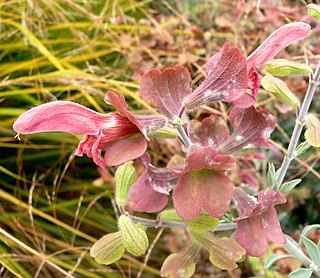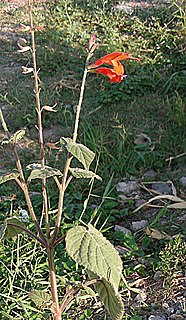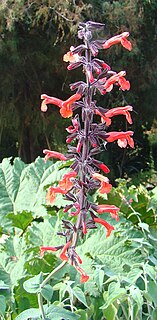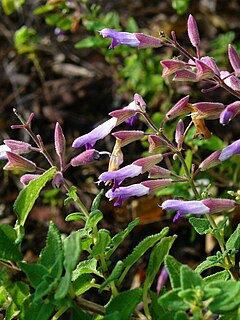
Salvia spathacea, the California hummingbird sage, hummingbird sage, or pitcher sage, is a species of flowering plant in the family Lamiaceae, native to southern and central California growing from sea level to 610 m (2,001 ft). This fruity scented sage blooms in March to May with typically dark rose-lilac colored flowers. It is cultivated in gardens for its attractive flowering spikes and pleasant scent.

Plectranthus scutellarioides, commonly known as coleus, is a species of flowering plant in the family Lamiaceae, native to southeast Asia through to Australia. Typically growing to 60–75 cm (24–30 in) tall and wide, it is a bushy, woody-based evergreen perennial, widely grown for the highly decorative variegated leaves found in cultivated varieties. Another common name is painted nettle, reflecting its relationship to deadnettles, which are in the same family. The synonyms Coleus blumei and Solenostemon scutellarioides are also widely used names for this species.
Salvia sprucei is a herbaceous perennial in the family Lamiaceae that is native to Ecuador, growing at 7,000 feet (2,100 m) elevation or higher in thick scrub on steep slopes. It was named in 1898 by botanist John Isaac Briquet for the British plant collector Richard Spruce. It is likely that Spruce discovered the plant on a collecting trip in Ecuador in 1857.

Salvia microphylla, the baby sage, Graham's sage, or blackcurrant sage, is an evergreen shrub found in the wild in southeastern Arizona and the mountains of eastern, western, and southern Mexico. It is a very complex species which easily hybridizes, resulting in numerous hybrids and cultivars brought into horticulture since the 1990s. The specific epithet microphylla, from the Greek, means "small leaved". In Mexico, it is called "mirto de montes," or "myrtle of the mountains."

Salvia brandegeei, the Santa Rosa Island sage or Brandegee's sage, is a perennial evergreen shrub that grows to 3–4 feet in its native habitat. For many years, it was thought to be native only to Santa Rosa Island, one of the Channel Islands of California. In the 1960s and 1970s six colonies were found in Baja California. In cultivation, the plant will reach 4–5 feet tall and up to 7 feet (2.1 m) wide. It has dark green scalloped leaves, about 3-4 inches long and 0.5 inch wide. The pale lavender flowers are about 0.5 inch long, in tightly spaced whorls. The violet-gray calyx, combined with the wide open flower lips, make it a very showy flower.

Salvia chiapensis is a herbaceous perennial native to the province of Chiapas, Mexico, growing between 7000 and 9500 feet elevation in cloud forests. It was introduced to horticulture in the 1980s, probably as a result of a collecting trip by the University of California Botanical Garden, Berkeley.

Salvia lanceolata is a perennial shrub native to a small area of coast on the Cape of Good Hope in South Africa. It is typically found growing in sandy ground at sea level, and on dry hills and flat ground up to 1000 feet elevation. Jean-Baptiste Lamarck, a pioneer in evolutionary theory, first described and named the plant "lanceolata" in 1791. Swedish botanist Carl Peter Thunberg, who was delayed in South Africa on the way to Japan, first collected it nearly twenty years earlier, along with approximately 3,000 plants that he later described. It wasn't until 1800 that Thunberg gave the plant the specific epithet "nivea", meaning 'snowy' in Latin, referring to the color of the foliage. Because of the rules of nomenclature, Lamarck's name had precedence because he was the first to name it.

Salvia longispicata is a perennial shrub native to southwestern Mexico, growing between 1,000 and 6,500 feet elevation. The specific epithet "longispicata" gives the impression that the plant has "long spikes", but instead refers to the many projecting clusters of short flowering spikes that resemble small ears of corn.
Salvia lycioides is a perennial native to a wide area ranging from west Texas and New Mexico in the U.S., south through Mexico to the state of San Luis Potosi. It typically grows on dry limestone hills and canyons above 5,000 feet elevation. It was named in 1886 by Asa Gray, the most respected American botanist of the 19th century. The specific epithet, "lycioides", from the Greek, is due to the plant's resemblance to Lycium, a genus also known as "boxthorn" in the nightshade family.
Salvia merjamie is a herbaceous perennial plant that is native to the east African highlands from Ethiopia to Tanzania, and also across the Red Sea in Yemen. It grows between 6,000 and 13,000 feet elevation in grasslands, forest edges, rocky outcrops, basalt slopes, and fallow fields. The specific epithet merjamie is derived from meryamiye, the Arabian common name for the plant, which is shared with other local Salvia species such as Salvia lanigera. The Maasai common name for S. merjamie is Naingungundeu, meaning that the plant smells of rats, though the variety that is common in horticulture is named 'Mint Sauce' and is described as having a strong minty aroma. S. merjamie shares a similar distribution with Salvia nilotica, though they are not known to hybridize.
Salvia namaensis is an evergreen perennial shrub native to a limited area in Namibia and a wide area of South Africa. It is typically found growing on rocky slopes, shales, limestone hills, and sandy soils at 1,000 to 5,000 feet elevation. The specific epithet namaensis probably refers to the Nama tribe which is indigenous to Namaqualand, the region in Namibia where the plant grows.

Salvia oppositiflora is a perennial native to Peru, growing at high elevations—7,000 to 12,000 feet. It was collected in 1798 by Hipólito Ruiz López and José Antonio Pavón Jiménez and later described in Flora of Peru.

Salvia recurva is a woody-based perennial native to the cloud forests of Central America, limited to the northern slopes of Oaxaca, Chiapas, and Guatemala at elevations around 10,000 feet (3,000 m). It grows where there is year-round warmth and abundant moisture in the air and on the forest floor. Salvia recurva was described by George Bentham in 1848, with the specific epithet referring to the distinct curve in the inflorescence when it first appears.

Salvia ringens is a hardy herbaceous perennial native to the southern and eastern parts of the Balkan Peninsula. With many colonies growing on Mount Olympus, the traditional "home of the gods," at altitudes up to 6,200 feet (1,900 m). Elsewhere, it grows in scrub and coniferous woodland between 1,600 feet (490 m) and 4,200 feet (1,300 m). It was grown in English gardens before 1913, and was described by William Robinson in the twelfth edition of The English Flower Garden in 1933. It dropped from sight before being rediscovered in the late 1990s.

Salvia rubescens is a herbaceous perennial native to the state of Mérida in Venezuela. The University of California Botanical Garden had been growing it since 1993 from a plant collected that year in Venezuela, only identifying it as S. rubescens in 2001.

Salvia scabra is a herbaceous perennial native to the southeastern strand of the Cape of Good Hope in South Africa, growing on sandy shores, coastal brush, and hilly slopes up to an elevation of 600 feet. It was described and named by Carl Thunberg in 1800. The leaves and an extract from the roots have been used medicinally in its native region for at least one hundred years. Salvia scabra was introduced to California gardens around 1996, and is extremely adaptable to many types of conditions. Since then it has spread to gardens in England, France, and Italy.

Salvia semiatrata is a perennial native to the Sierra Madre del Sur in the Mexican state of Oaxaca, growing at elevations of 6,500 ft (2,000 m) or higher. It prefers the edges of pine forests, and is also found on limestone cliffs and banks and in cactus scrub habitats that are dry and exposed.
Salvia shannoni is a tender perennial native to the Mexican state of Chiapas, and to Guatemala, El Salvador, and Honduras, growing in or near pine forests at approximately 3,000–5,000 feet elevation. Its native habitat receives regular moisture in the form of fog, rain, and streams, with mild temperatures that stay above freezing. The plant was named by botanist John Donnell Smith in 1893 for William Cummings Shannon, who collected it in the wild. The two were apparently serving in the United States military at the same time. Even though it has been grown in Central America for many years, it is relatively new to horticulture in North America. In El Salvador it has been used for treating malaria, and is known as monte amargo, or "bitterwood.

Salvia thymoides is an evergreen perennial shrub native to a small region in Mexico on the border of Oaxaca and Puebla states, growing at elevations from 7,000 feet (2,100 m) to 9,000 feet (2,700 m). Its native habitat is cloud forest, with the mountains catching regular moisture in the form of fog and rain. The plant was named by the botanist George Bentham in 1833, with the specific epithet, thymoides, referring to the small leaves which resemble those of thyme. It has a limited use in horticulture, introduced in the 1980s.
Salvia tubiflora is a perennial native to a small area of western Peru and northern Chile near the tropic of Capricorn, growing at elevations from 800 feet (240 m) to 1,600 feet (490 m).














